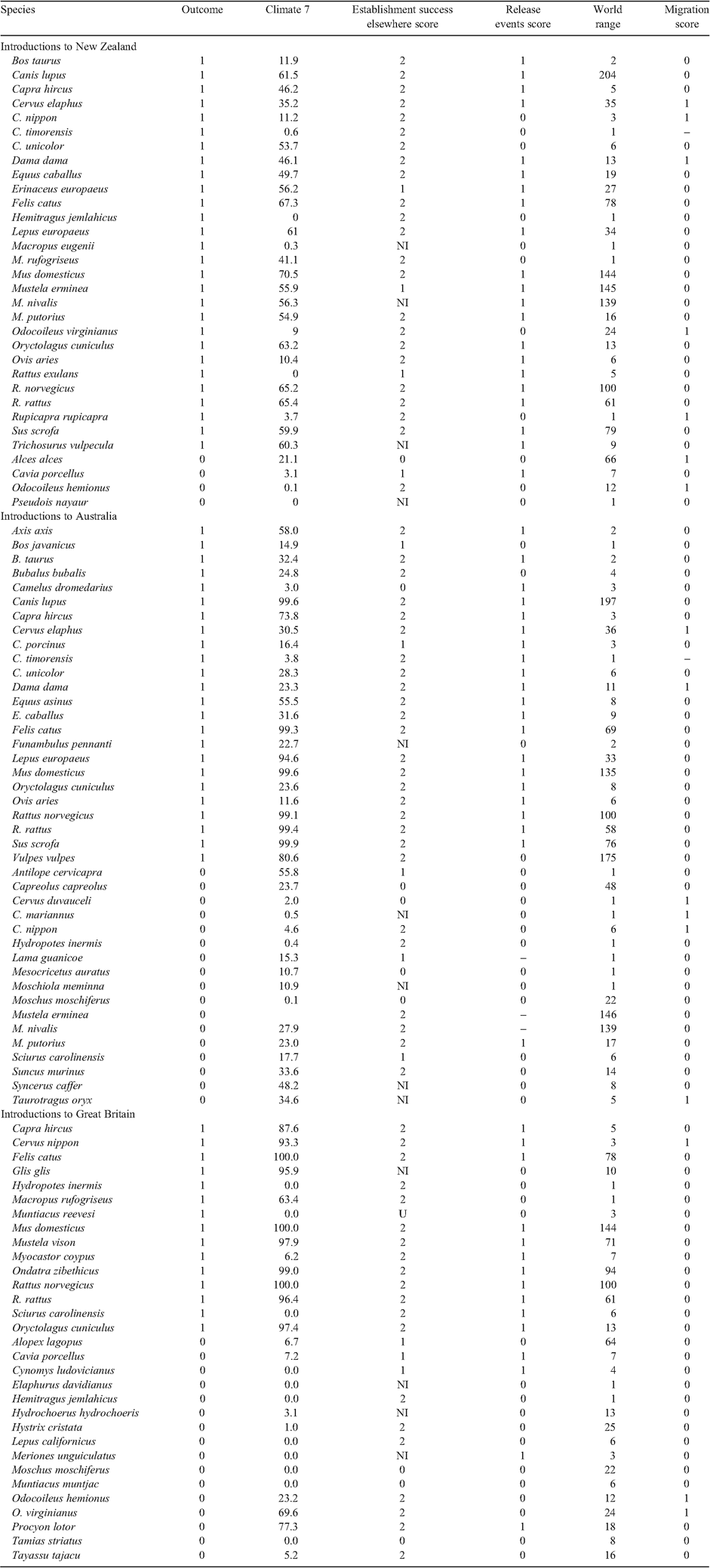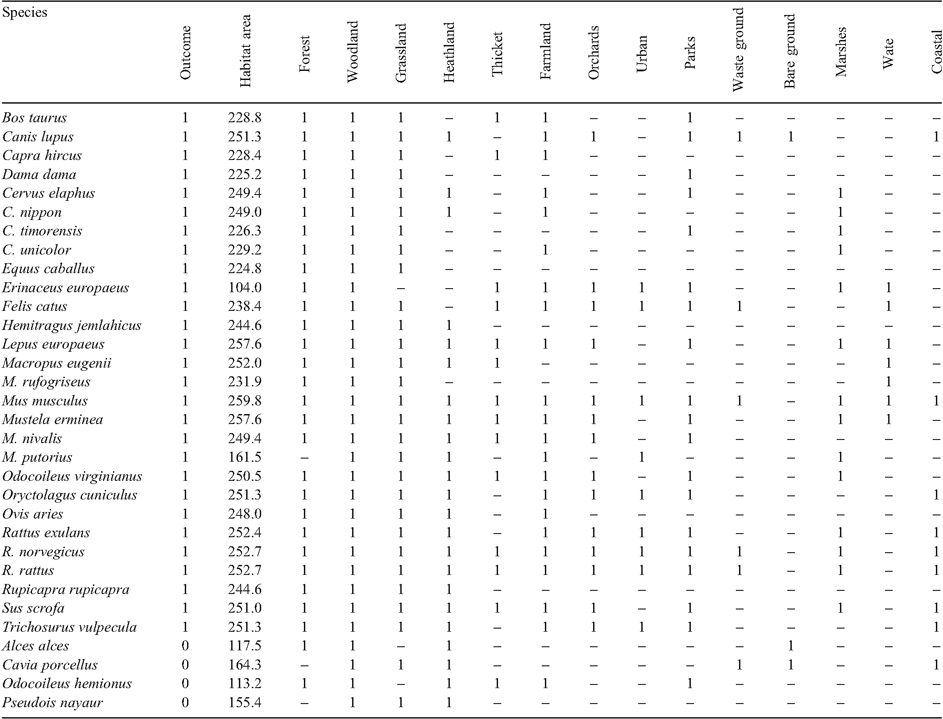Determinants of establishment success for introduced exotic mammals
Mary Bomford A , Rebecca O. Darbyshire A B and Lucy Randall A
+ Author Affiliations
- Author Affiliations
A Bureau of Rural Sciences, GPO Box 858, Canberra, ACT 2601, Australia.
B Corresponding author. Email: rebecca.darbyshire@brs.gov.au
Wildlife Research 36(3) 192-202 https://doi.org/10.1071/WR08055
Submitted: 11 April 2008 Accepted: 10 February 2009 Published: 15 April 2009
Abstract
We conducted comparisons for exotic mammal species introduced to New Zealand (28 successful, 4 failed), Australia (24, 17) and Britain (15, 16). Modelling of variables associated with establishment success was constrained by small sample sizes and phylogenetic dependence, so our results should be interpreted with caution. Successful species were subject to more release events, had higher climate matches between their overseas geographic range and their country of introduction, had larger overseas geographic range sizes and were more likely to have established an exotic population elsewhere than was the case for failed species. Of the mammals introduced to New Zealand, successful species also had larger areas of suitable habitat than did failed species. Our findings may guide risk assessments for the import of live mammals to reduce the rate new species establish in the wild.
Acknowledgements
Funding was provided by the Australian Invasive Animals Cooperative Research Centre. L. Walter assisted with climate matching and calculating overseas range sizes. B. Raphael and L. Brown and three anonymous referees provided constructive comments. C. M. King provided advice on mammals established in New Zealand. S. Barry (CSIRO) and E. Lawrence (BRS) provided advice on statistical analyses.
References
Andersen, M. C. , Adams, H. , Hope, B. , and Powell, M. (2004). Risk assessment for invasive species. Risk Analysis 24, 787–793.
| Crossref | GoogleScholarGoogle Scholar | PubMed |
Bentley
A.
(1998). ‘An Introduction to the Deer of Australia.’ (Australian Deer Research Foundation: Melbourne.)
Bomford
M.
(2003). ‘Risk Assessment for the Import and Keeping of Exotic Vertebrates in Australia.’ (Bureau of Rural Sciences: Canberra.)
Bomford, M. , Kraus, F. , Barry, S. C. , and Lawrence, E. (2009). Predicting establishment success for alien reptiles and amphibians: a role for climate matching. Biological Invasions 11, 713–724.
| Crossref | GoogleScholarGoogle Scholar |
Brands
S. J.
(comp.) (1989–2008). ‘Systema Naturae (2000).’ The Taxonomicon. (Universal Taxonomic Services: Amsterdam, The Netherlands.) Available at http://sn2000.taxonomy.nl/Taxonomicon/ [Accessed October 2007].
Bureau of Rural Sciences (2006). ‘CLIMATE.’ PC based software. (Bureau of Rural Sciences, Department of Agriculture, Fisheries and Forestry: Canberra.) Available at http://affashop.gov.au/product.asp?prodid=13506 [Verified 11 March 2009]
Bureau of Rural Sciences (2009). ‘CLIMATCH.’ Free-access internet-based software. (Bureau of Rural Sciences, Department of Agriculture, Fisheries and Forestry: Canberra.) Available at http://www.brs.gov.au/Climatch/ [Verified 11 March 2009]
Busby
J. R.
(1991). BIOCLIM – A bioclimate analysis and prediction system. In ‘Nature Conservation: Cost Effective Biological Surveys and Data Analysis’. (Eds C. R. Margules and M. P. Austin.) pp. 64–68. (CSIRO: Canberra.)
de Vos, A. , Manville, R. H. , and Van Gelder, R. G. (1956). Introduced mammals and their influence on native biota. Zoologica 41, 163–194.
Duncan
R. P.
, and
Forsyth
D. M.
(2005). Competition and the assembly of introduced bird communities. In ‘Conceptual Ecology and Invasions Biology’. (Eds M. W. Cadotte, S. M. McMahon and T. Fukami.) pp. 415–431. (Springer: Berlin.)
Duncan, R. P. , Bomford, M. , Forsyth, D. M. , and Conibear, L. (2001). High predictability in introduction outcomes and the geographical range size of introduced Australian birds: a role for climate. Journal of Animal Ecology 70, 621–632.
| Crossref | GoogleScholarGoogle Scholar |
Fitter
R. S. R.
(1959). ‘The Ark in Our Midst.’ (Collins: London.)
Fitzpatrick
B. M.
(1878). ‘Irish Sport and Sportsmen.’ (M. H. Gill and Son: Dublin.)
Forsyth, D. M. , and Duncan, R. P. (2001). Propagule size and the relative success of exotic ungulate and bird introductions to New Zealand. American Naturalist 157, 583–595.
| Crossref | GoogleScholarGoogle Scholar |
CAS |
PubMed |
Good
P. I.
, and
Hardin
J. W.
(2003). ‘Common Errors in Statistics (and How to Avoid Them).’ (John Wiley & Sons: Hoboken, NJ.)
Hayes, K. R. , and Barry, S. C. (2008). Are there any consistent predictors of invasion success? Biological Invasions 10, 483–506.
| Crossref | GoogleScholarGoogle Scholar |
Hinton
H. E.
, and
Dunn
A. M. S.
(1967). ‘Mongooses: Their Natural History and Behaviour.’ (Oliver and Boyd: London.)
Holdgate, M. W. (1986). Summary and conclusions: characteristics and consequences of biological invasions. Philosophical Transactions of the Royal Society of London. Series B, Biological Sciences 314, 733–742.
| Crossref | GoogleScholarGoogle Scholar |
King
C. M.
(Ed.) (2005). ‘The Handbook of New Zealand Mammals.’ 2nd edn. (Oxford University Press: Melbourne.)
Kolar, C. S. , and Lodge, D. M. (2001). Progress in invasion biology: predicting invaders. Trends in Ecology & Evolution 16, 199–204.
| Crossref | GoogleScholarGoogle Scholar |
Kriticos
D. J.
, and
Randall
R. P.
(2001). A comparison of systems to analyse potential weed distributions. In ‘Weed Risk Assessment’. (Eds R. H. Groves, F. D. Panetta and J. G. Virtue.) pp. 61–79. (CSIRO: Melbourne.)
Lande, R. (1993). Risks of population extinction from demographic and environmental stochasticity and random catastrophes. American Naturalist 142, 911–927.
| Crossref | GoogleScholarGoogle Scholar |
Long
J. L.
(2003). ‘Introduced Mammals of the World: Their History, Distribution and Influence.’ (CSIRO Publishing: Melbourne.)
Lund
M.
(1994). Commensal rodents. In ‘Rodent Pests and Their Control’. (Eds A. P. Buckle and R. H. Smith.) pp. 23–43. (CAB International: Wallingford, UK.)
McKenna
M. C.
, and
Bell
S. K.
(1997). ‘Classification of Mammals Above the Species Level.’ (Columbia University Press: New York.)
Myers
K.
(1986). Introduced vertebrates in Australia with emphasis on the mammals. In ‘Ecology of Biological Invasions: An Australian Perspective’. (Eds R. H. Groves and J. J. Burdon.) pp. 120–136. (Australian Academy of Science: Canberra.)
Noble
I. R.
(1989). Attributes of invaders and the invading process: terrestrial and vascular plants. In ‘Biological invasions: a global perspective’. (Ed. J. A. Drake.) pp. 301–313. (John Wiley & Sons Ltd.: Chichester, UK.)
Parker
S. P.
(Ed.) (1990). ‘Grzimek’s Encyclopedia of Mammals. Vols 1–5.’ (McGraw-Hill: New York.)
Pheloung
P. C.
(1996). ‘CLIMATE: a system to predict the distribution of an organism based on climate preferences.’ (Department of Agriculture: Perth.)
Pimentel
D.
(Ed.) (2002). ‘Biological Invasions: Environmental and Economic Costs of Alien Plant, Animal, and Microbe Invasions.’ (CRC Press: New York.)
Pimentel, D. , Lach, L. , Zuniga, R. , and Morrison, D. (2000). Environmental and economic costs of nonindigenous species in the United States. Bioscience 50, 53–65.
| Crossref | GoogleScholarGoogle Scholar |
Ramsey
F. L
, and
Schafer
D. W.
(2002). ‘The Statistical Sleuth, a Course in Methods of Data Analysis.’ 2nd edn. (Duxbury: Pacific Grove, CA.)
Randall
L. A.
,
Bomford
M.
,
Pratt
S. J.
, and
Crombie
J.
(2007). Can climate matching and habitat availability be used to predict the distribution of introduced birds? In ‘Atlas of Bird Distribution in New Zealand 1999–2004’. (Eds C. J. R. Robertson, P. Hyvonen, M. J. Fraser and C. R. Pickard.) pp. 369–374. (Ornithological Society of New Zealand: Wellington.)
Sikder, I. U. , Mal-Sarkar, S. , and Mal, T. K. (2006). Knowledge-based risk assessment under uncertainty for species invasion. Risk Analysis 26, 239–252.
| Crossref | GoogleScholarGoogle Scholar | PubMed |
Strahan
R.
(Ed.) (1995). ‘The Mammals of Australia.’ (Reed Books: Sydney.)
Sutherst
R. W.
,
Maywald
G. F.
,
Yonow
T.
, and
Stevens
P. M.
(1998). ‘CLIMEX. Predicting the Effects of Climate on Plants and Animals. Users guide.’ (CSIRO: Melbourne.)
Thomson
G. M.
(1922). ‘The Naturalisation of Animals and Plants in New Zealand.’ (Cambridge University Press: Cambridge, UK.)
Williamson
M.
(1989). Mathematical models of invasion. In ‘Biological Invasions. A Global Perspective’. (Eds J. A. Drake, H. A. Mooney, F. di Castri, R. H. Groves, F. J. Kruger, M. Rejmanek and M. W. Williamson.) pp. 329–350. (John Wiley and Sons: Chichester, UK.)
Williamson, M. (1999). Invasions. Ecography 22, 5–12.
| Crossref | GoogleScholarGoogle Scholar |
Wodzicki
K. A.
(1950). ‘Introduced Mammals of New Zealand: an Ecological and Economic Survey.’ (DSIR Bulletin 98: Wellington, NZ.)
Yalden
D. W.
(1999). ‘The History of British Mammals.’ (Poyser: London.)
Appendix 1. Exotic mammal species introduced to New Zealand, Australia and Great Britain
The following species were excluded from the analyses: NEW ZEALAND: Axis axis established a small self-sustaining wild population that was eradicated by hunting (Thomson 1922); an unknown Dasyurus sp. was unsuccessfully introduced to New Zealand (Thomson 1922); Pseudocheirus perigrinus and Lama vicugna were imported; however, it is uncertain whether they were released (Thomson 1922); Procyon lotor, Spermophilus beecheyi and Tamais striatus were also imported and it is unclear whether there was a release event of two or more animals for these species (Thomson 1922); AUSTRALIA: Canis aureus was reported being released in Victoria as a substitute for foxes for sport hunting (Fitzpatrick 1878); probably these jackals were released singly and hunted and killed soon after their release; Myers (1986) reported that zebra (Equus sp.) was released; however, we were unable to confirm the species or whether more than one individual was released; Long (2003) reported unconfirmed releases of Alces alces and Vicugna vicugna; BRITAIN: Lepus europaeus, Castor fibre, Sus scrofa, Micromys minutus, Canis lupus, Mustela putorius, Rangifer tarandus, Capreolus capreolus and Dama dama may all have been originally native (Yalden 1999); Mesocricetus auratus has established many times; however, populations have always been eradicated before becoming widespread (Long 2003), so its potential status is uncertain; Hystrix brachyura established a small breeding population that was eradicated by trapping (Baker 1990; Long 2003); Nyctomys sumichrasti is ‘not infrequently found in consignments of bananas in London, the Welsh ports, and no doubt elsewhere’ according to Fitter (1959); however, it is uncertain whether this species has ever been released from containment; Baker (1990) lists the following three escaped species that were present in the wild only for less than 10 days before being killed or caught: Papio hamadryas; Panthera tigris; Neofelis nebulosa. The following three species that are not now present or are uncommon in the wild were included as successful: NEW ZEALAND: feral dog (Canis lupus) packs were present in the 19th century (Thomson 1922) and are still not wholly restricted to human settlements (Atkinson 2006); BRITAIN: Myocastor coypus and Ondatra zibethicus were included because both exotic species were so widespread before their intentional eradication that it is clear they could have sustained wild populations. Outcome: 1 = successfully established; 0 = released but failed to establish. Climate match scores are presented as percentages of the total number of grid squares (or meteorological stations for Britain) in the country being assessed. Establishment success elsewhere score: 0 = introduced and failed; 1 = established overseas on small islands (<50 000 km−2); 2 = established overseas on larger islands (≥50 000 km−2) or a continent; NI = never introduced elsewhere; U = introduced elsewhere but success uncertain. Release events score: 0 = 1–4; 1 = >4 recorded release events of the species in country being assessed (after Forsyth et al. 2004). A single release event may be of any number of individual animals. World-range size (millions of km2), excluding range in country being assessed. For species introduced to New Zealand from Australia, we included their former distribution at the time of European settlement (Strahan 1995). Migration score: 0 = non-migratory; 1 = migratory

|
Appendix 2. Appendix 2. Habitats exotic mammal species introduced to New Zealand use in their overseas ranges
Outcome: 1 = successfully established; 0 = released but failed to establish. Habitat area indicates area of suitable habitat in New Zealand (×1000 km2). Habitats commonly used in overseas range: 1 = present; – = absent

|




